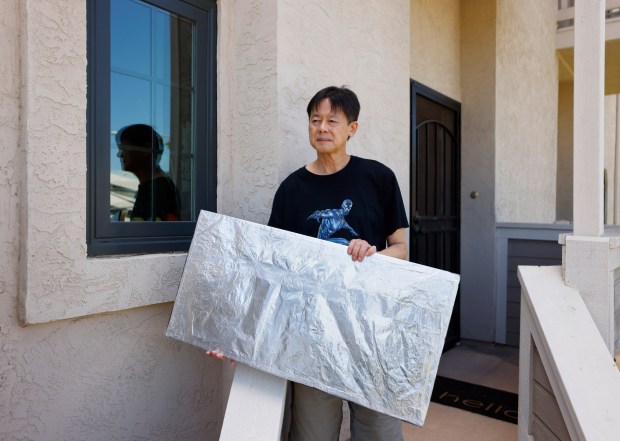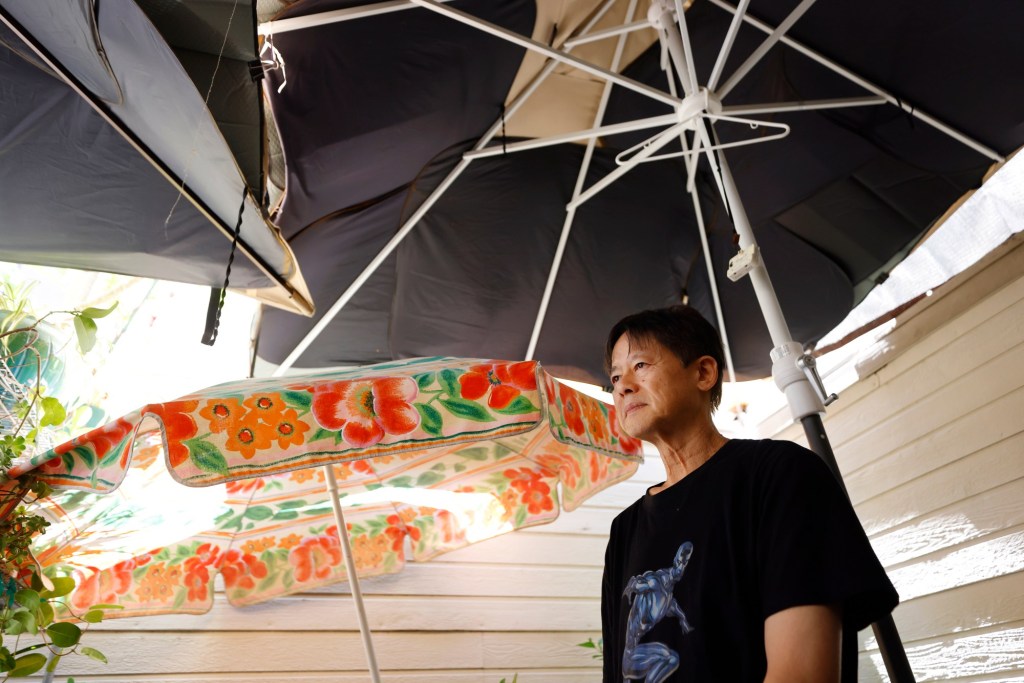There are the people who turn the light off every time they leave a room and try to run appliances at off-peak times to save energy.
And then there’s Soo Hom, a 59-year-old systems administrator who works for UC San Diego. He has run the air conditioner in his 930-square-foot townhome for 24 hours.
Not in the past day. In the past year.
“Just a few times,” Hom said, “for just one to two hours a day.”
Hom doesn’t like his home toasty. He doesn’t love humidity. But he has hacked his space to make climate control using gas or electricity (almost) irrelevant.
“It all started out when I was a kid,” he said. “My parents are from China. And they didn’t have much money, so they’re used to living frugally, with no A/C and hardly any heat.”
The Homs ran a Chinese laundry downtown, on E Street, “a block away from the San Diego Public Library.”
“So I kind of carried on the traditions,” Hom said, “even though with global warming, it’s getting hotter. So it’s been hard to live without A/C.”
 Soo Hom holds a foam panel that he uses to cover his windows to regulate temperature and keep his energy bill down at his University City home. (K.C. Alfred / The San Diego Union-Tribune)
Soo Hom holds a foam panel that he uses to cover his windows to regulate temperature and keep his energy bill down at his University City home. (K.C. Alfred / The San Diego Union-Tribune)
Since 1970, when Hom was a young boy, San Diego County’s average summer temperature is 3.2 degrees higher, according to Climate Central, a non-partisan, evidence-based climate change research nonprofit.
Actually, he said, he is even more frugal today, “because I know the things I can do to not use the heat.”
There is one more reason Hom does not want to run up his utility bill: He has strong feelings about San Diego Gas & Electric. He is concerned with the utility’s incentives, its profit model, and how it operates. His critique amounted to this: “They are way overcharging people.”
The average SDG&E electric bill for a bundled customer, who uses gas and electric, was an estimated $166 in February, according to SDG&E. The average gas bill was projected to be $68.
Hom pays around $90 in the winter and $100 in the summer. The $10 difference is because he uses fans.
Hom would rather give his money to Home Depot or Amazon, for the cost of the materials he uses to keep his energy bill low.
A third reason why he’s made these upgrades: He is a remote worker. Before the pandemic, he would walk in the door after work and it would be hot, and he would open the patio umbrellas to keep the living room shaded.
“But working from home, that’s when my projects went into overdrive, and I would just walk around the house and find all the hot spots and figure out some way to stop the sun from heating up (that) part of the house,” he said.
The materials
Over the 25 years or so he’s lived in his three-story University City townhome, Hom has invested several thousand dollars into his energy efficiency upgrades. Here is what he bought, with prices at the time of purchase unless otherwise noted:
Low-E3 and low-E4 windows and a sliding glass door. These cost him around $12,000. They are more useful in the winter to keep the heat in, than in the summer. “I bought all that stuff and I was still hot,” he said. “They’re rated to reduce the sun’s heat by 80% but that other 20% will still get you. It just takes longer.”
Foam insulation. He has spent around $60 on three large foam boards, which he custom cuts and places against doors and windows, depending on the season or time of day.
Front security door. This cost around $500, including installation. He sometimes leaves the wood front door open and lets the cooler outside air in through the sturdy screened metal security door. In the mornings, when light streams into his kitchen, he also puts one or two layers of foam insulation between the security door and the main door, which keeps his kitchen much cooler.
Car sunshields. He bought 20 of these shields, which are designed to help car interiors from heating up. At around $20 apiece, that comes out to around $400. He puts these on the patio umbrellas’ undersides to keep the sun from hitting the patio even through the umbrella.
Patio umbrellas. This got him started on thinking about blocking out the sun’s heat. He has two, and replaces them at most every five years. Pricier ones made of better fabric do last longer. “Now it’s hard to find good umbrellas that aren’t expensive,” he added. The two he has now are priced at $529 and have “very durable” Sunbrella fabric. Together they are big enough to “block 92% of the sun in that part of the patio,” he said. Hom had also bought umbrellas from Costco and World Market.
Three “Hurricane” brand box fans. He puts these 20-by-20-inch fans on windowsills and between rooms, to pull the cooler air from outside. These are most useful upstairs, where “it gets really hot from the sun heating the roof during the day.” Hom compared brands and found that this brand, Hurricane, has a higher wind rating than comparable ones made by competitors. They are around $40 on Amazon.
Aluminum shade cloth. This is his most recent, and favorite, investment, which cost $20. He described it in his blog, The Hungry Ones.
“I bought a 10×10 aluminum shade cloth with 99% reflectance to place over the patio umbrella I used to keep the sun off my living room patio door,” he writes. He shows how he installed it, with several close-up photos, took temperature measurements before and after, and posts the result:
“In conclusion adding the aluminum shade cloth to the top of my patio umbrella has cooled the umbrella down over 10F. My patio is now a few degrees warmer than the air temperature in my ZIP code. This is an amazing result as in the past my patio was like an oven from the sun heating it up till near sunset.”
A last tool he uses is an infrared thermometer, which he bought about two months ago to find hot spots. That cost around $40 or $50, he estimated.
When the heat gets too much or the forecast shows unbearably high temperatures, he does use the A/C. He runs it from 4 a.m. to 5 a.m. for an hour or two, before the super off-peak rate expires. He cools the house down to around 70 degrees and then lets it gradually warm up again. Adding up these cooling bursts over the past year, they come out to 24 hours, he said.
Pros and cons
Since 2020, Hom has invested more than $12,000 — the bulk of which is windows and doors. Was it worth it, compared to how much he would have spent on gas and electricity since 2020?
“There’s a big upfront cost. There’s pretty much no cost afterward, and the longer you stay, the better the return.” Hom, who owns his home, does not plan on moving because he doesn’t want to pay more in property taxes. “So, based on that, I’m pretty much stuck here unless I get a large infusion of income.”
But these investments won’t make sense for everyone.
“It would be a bad move to buy new windows if you’re nomadic. I would totally dissuade anyone from investing in all this work and cost if you’re a mover. I try not to move, and I’ve been pretty successful at it,” Hom said.
Blocking the sunlight also darkens his living spaces.
Using less energy also has a benefit for the environment, he said. “If you’re an environmentalist, then you would probably find that it’s better for the environment for you to buy the insulation and use it over a lifetime, rather than keep paying SDG&E to produce gas and electricity for you,” he said.
Hom is frugal with energy in ways that go beyond heating and cooling. “I do avoid using power during peak hours,” he said. His light bulbs are all LEDs and he hangs clothes up to dry. “We don’t use lights much. We don’t use the dishwasher much and it’s mostly a drying rack.”
He told his two housemates — his girlfriend and her child — about his frugal ways before they moved in, so they knew what they were getting into.
“If you’re not on board, you’re probably not going to want to get on board,” he said. “They are agreeable to my terms.”
The money he doesn’t spend on that utility bill goes toward fun. It lets him travel and indulge in one of his favorite dishes in San Diego, the sea bass at Emerald Chinese Cuisine.
“It’s got a little crispy outside and the inside (is) tender, flaky and juicy,” he said. His blog covers food and travel adventures with his girlfriend between occasional posts about saving energy and other home projects.
His residence is part of a homeowner’s association, and the windows were approved. He hasn’t run the aluminum shade cloth by the HOA.
Hom could make these changes because he is a homeowner. But he offered this takeaway: the expensive windows make a small difference in the summer and do help in the winter. But the biggest difference in the winter is free: he bundles up. In the summer, the upgrades that made the biggest difference were not the most expensive.
“I would say the foam insulation and the insulated patio umbrellas make more of a difference than the windows.” Those are changes a renter could make.
